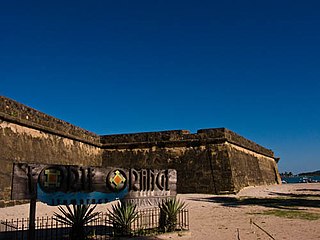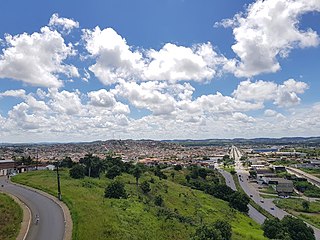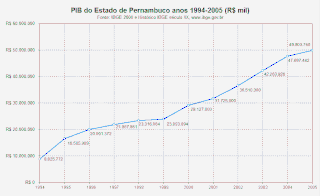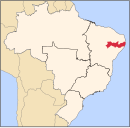
Recife is the fourth-largest urban area in Brazil with 4,054,866 inhabitants, the largest urban area of the North/Northeast Regions, and the capital and largest city of the state of Pernambuco in the northeast corner of South America. The population of the city proper was 1,653,461 in 2020. Recife was founded in 1537, during the early Portuguese colonization of Brazil, as the main harbor of the Captaincy of Pernambuco, known for its large scale production of sugar cane. It was the former capital Mauritsstad of the 17th century colony of New Holland of Dutch Brazil, established by the Dutch West India Company. The city is located at the confluence of the Beberibe and Capibaribe rivers before they flow into the South Atlantic Ocean. It is a major port on the Atlantic. Its name is an allusion to the stone reefs that are present by the city's shores. The many rivers, small islands and over 50 bridges found in Recife city centre characterise its geography and led to the city being called the "Brazilian Venice". As of 2010, it is the capital city with the highest HDI in Northeast Brazil and second highest HDI in the entire North and Northeast Brazil.

Pernambuco is a state of Brazil, located in the Northeast region of the country. With an estimated population of 9.6 million people as of 2020, making it seventh-most populous state of Brazil and with around 98,148 km², being the 19th-largest in area among federative units of the country, it is the sixth-most densely populated with around 89 people per km². Its capital and largest city, Recife, is one of the most important economic and urban hubs in the country. Based on 2019 estimates, the Recife Metropolitan Region is seventh-most populous in the country, and the second-largest in northeastern Brazil. In 2015, the state had 4.6% of the national population and produced 2.8% of the national gross domestic product (GDP).

Ilha de Itamaracá is a tropical island and municipality in Pernambuco, Brazil on the Atlantic Ocean. Itamaracá means "stone shaker" in Tupi, from the words itá ("stone") and mbara'ká ("shaker"). It is separated from the mainland by the Canal de Santa Cruz, a salt water channel both mouths of which are on the Atlantic Ocean, and is connected to the mainland by a long road bridge.

Caruaru is a Brazilian municipality in the state of Pernambuco. The most populous city in the interior of the state, Caruaru is located in the microzone of Agreste and because of its cultural importance, it is nicknamed Capital do Agreste, Princesinha do Agreste, and Capital do Forró.

Goiana is a city in Brazil in the northeast of the state of Pernambuco, roughly 65 km north of the city of Recife, 51 km from the capital of Paraíba and 2,187 km from Brasília.

Maragogi is a municipality in the Brazilian state of Alagoas, 125 km north of the capital city of Maceió. It has 33,032 inhabitants, a city situated on the northern coast of Alagoas state, Brazil, being the easternmost city of that state.

Igarassu is a city in the Brazilian state of Pernambuco. It is the second oldest city of the country and is situated on the north coast of the metropolitan region of Recife, approximately 32 kilometres (20 mi). It stands as one of the earliest European settlements in Brazil and is the site of the oldest church in the country, the Church of Saints Cosme and Damião, built in 1535. Igarassu is home to numerous colonial-period historic structures. The historic center of the city was designated a national monument by the National Institute of Historic and Artistic Heritage (IPHAN) in 1972.

Cabo de Santo Agostinho is a 448 square kilometer sized municipality located 35 kilometers south of the city of Recife, Pernambuco, Brazil. It is believed by some historians that Vicente Yáñez Pinzón had set anchor in a bay in Cabo de Santo Agostinho on January 26, 1500, however the Portuguese discovery of Brazil was by Pedro Álvares Cabral on April 21, 1500 is officially recognized instead. Cabo de Santo Agostinho was incorporated as a town in 1811.

Tamandarë is a coastal municipality about 103 km (64 mi) south of Recife, the capital city of the Brazilian state of Pernambuco.

Vitória de Santo Antão is a city in Pernambuco State, Brazil, 46 kilometers west of Recife. Its territorial area is 335,942 km², 5,717 km² of which lies within the urban perimeter. In 2021, the Brazilian Institute of Geography and Statistics (IBGE) estimated its population at approximately 140 389 inhabitants, being the tenth most populous city in Pernambuco, the fourth most populous in the interior of the state and the most populous in Zona da Mata. According to the Firjan Municipal Development Index (IFDM), Vitória de Santo Antão was elected the 8th best city of Pernambuco to live in.

Belo Jardim a Brazilian municipality in the state of Pernambuco. It has an estimated population in 2020 of 76,687 and a total area of 647.7 km². It is located at 608 meters above the sea level and 182 km away from the state capital, Recife.

Sirinhaém is a municipality in Pernambuco with 46,361 inhabitants. The town was founded in 1614 making it among the oldest in the state. The Mayor is Camila Machado Leocadio Lins Dos Santos.

Porto de Galinhas is a beach in the municipality of Ipojuca, Pernambuco, Brazil. Porto de Galinhas is a major tourist destination. The beach is famous for its bright-water beaches and the natural pools. It is part of the municipality of Ipojuca, and located 60 kilometers (37 mi) south of the state capital, Recife. The municipality of Ipojuca, where Porto de Galinhas lies, was established on November 12, 1895.
Itapissuma is a city in the state of Pernambuco, Brazil. It is integrated in the Recife metropolitan area with another 13 cities. Itapissuma has a total area of 74.25 square kilometers and had an estimated population of 26,900 inhabitants in 2020 according to the IBGE. The city has the best children's mortality rate in the metropolitan area and has also the second highest GDP per capita after Ipojuca.

Suape Port is one of the main ports of Brazil and Latin America. It's located in the city of Ipojuca and Cabo de Santo Agostinho, in the state of Pernambuco. It's the largest public port in the Northeast Region and occupies the fifth position in the national ranking.
São José da Coroa Grande is a city in Pernambuco with 21,586 inhabitants. It is southernmost city of the state on the coast section.

Rio Formoso, is a municipality in Pernambuco with 23,628 inhabitants.

Sairé is a municipality located in the state of Pernambuco, Brazil. Located at 110.7 km away from Recife, capital of the state of Pernambuco. Has an estimated population of 9,764 inhabitants.

The economy of the Brazilian state of Pernambuco is based on agriculture, animal husbandry and industries. The economy of the state, after stagnating from 1985 and 1995, has been growing rapidly since the end of the twentieth century. In 2000, the GDP per capita was R$3.673 ($2098), resulting in more than 40% growth in this period, and more than 10% in a year. In 2007, the GDP per capita grew up to R$7.337 ($4.217).




















